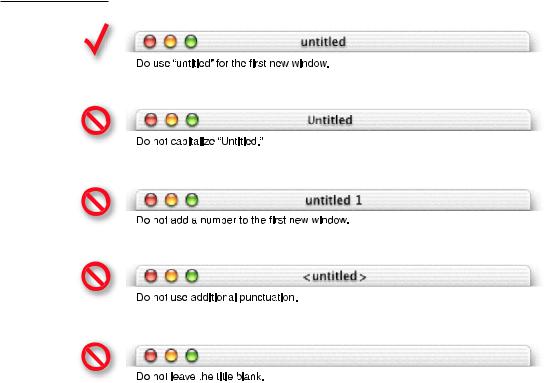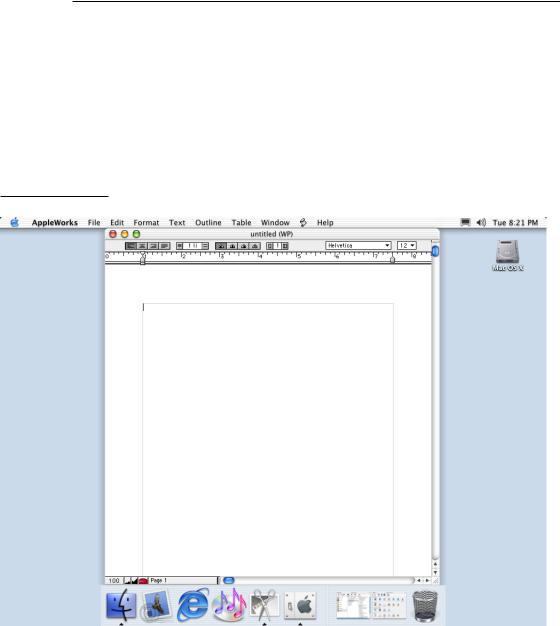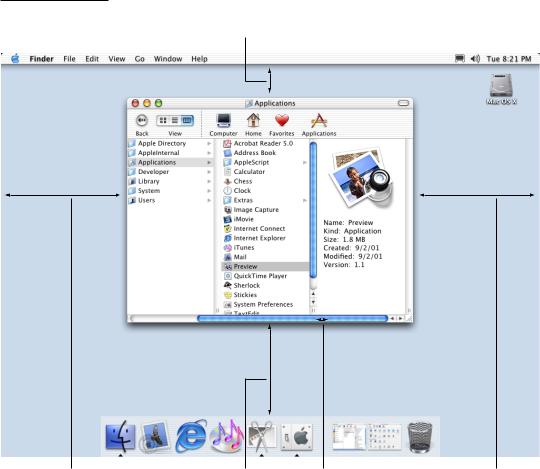
- •Contents
- •Figures and Tables
- •Introduction to the Aqua Human Interface Guidelines
- •The Benefits of Applying the Interface Guidelines
- •Deciding What to Do First
- •Tools and Resources for Applying the Guidelines
- •If You Have a Need Not Covered by the Guidelines
- •Human Interface Design
- •Human Interface Design Principles
- •Metaphors
- •See-and-Point
- •Direct Manipulation
- •User Control
- •Feedback and Communication
- •Consistency
- •WYSIWYG (What You See Is What You Get)
- •Forgiveness
- •Perceived Stability
- •Aesthetic Integrity
- •Modelessness
- •Knowledge of Your Audience
- •Worldwide Compatibility
- •Cultural Values
- •Language Differences
- •Default Alignment of Interface Elements
- •Resources
- •Universal Accessibility
- •Visual Disabilities
- •Hearing Disabilities
- •Physical Disabilities
- •The Dock
- •The Dock’s Onscreen Position
- •Dock Notification Behavior
- •Dock Menus
- •Clicking in the Dock
- •Menus
- •Menu Elements
- •Menu Titles
- •Menu Items
- •Grouping Items in Menus
- •Hierarchical Menus (Submenus)
- •Menu Behavior
- •Scrolling Menus
- •Toggled Menu Items
- •Sticky Menus
- •Standard Pull-Down Menus (The Menu Bar)
- •The Apple Menu
- •The Application Menu
- •The Application Menu Title
- •The Application Menu Contents
- •The File Menu
- •The Edit Menu
- •The View Menu
- •The Window Menu
- •The Help Menu
- •Menu Bar Status Items
- •Other Menus
- •Contextual Menus
- •Using Special Characters and Text Styles in Menus
- •Using Symbols in Menus
- •Using Text Styles and Fonts in Menus
- •Using Ellipses in Menus and Buttons
- •Windows
- •Window Layering
- •Window Appearance and Behavior
- •Textured Windows
- •Opening and Naming Windows
- •Positioning Windows
- •Closing Windows
- •Moving Windows
- •Resizing and Zooming Windows
- •Active and Inactive Windows
- •Click-Through
- •Scroll Bars and Scrolling Windows
- •Automatic Scrolling
- •Minimizing and Expanding Windows
- •Windows With Changeable Panes
- •Special Windows
- •Drawers
- •When to Use Drawers
- •Drawer Behavior
- •Utility Windows
- •The About Window
- •Dialogs
- •Types of Dialogs and When to Use Them
- •Document-Modal Dialogs (Sheets)
- •Sheet Behavior
- •When to Use Sheets
- •When Not to Use Sheets
- •Alerts
- •Dialog Behavior
- •Accepting Changes
- •The Open Dialog
- •Saving, Closing, and Quitting Behavior
- •Save Dialogs
- •Closing a Document With Unsaved Changes
- •Saving Documents During a Quit Operation
- •Saving a Document With the Same Name as an Existing Document
- •The Choose Dialog
- •The Printing Dialogs
- •Controls
- •Control Behavior and Appearance
- •Push Buttons
- •Push Button Specifications
- •Radio Buttons and Checkboxes
- •Radio Button and Checkbox Specifications
- •Selections Containing More Than One Checkbox State
- •Pop-Up Menus
- •Pop-Up Menu Specifications
- •Command Pop-Down Menus
- •Command Pop-Down Menu Specifications
- •Combination Boxes
- •Combo Box Specifications
- •The Text Entry Field
- •The Scrolling List
- •Placards
- •Bevel Buttons
- •Bevel Button Specifications
- •Toolbars
- •Pop-Up Icon Buttons and Pop-Up Bevel Buttons
- •Slider Controls
- •Slider Control Specifications
- •Tab Controls
- •Tab Control Specifications
- •Progress Indicators
- •Text Fields and Scrolling Lists
- •Tools for Creating Lists
- •Text Input Field Specifications
- •Scrolling List Specifications
- •Image Wells
- •Disclosure Triangles
- •Layout Guidelines
- •Group Boxes
- •Sample Dialog Layouts
- •Using Small Versions of Controls
- •User Input
- •The Mouse and Other Pointing Devices
- •Using the Mouse
- •Clicking
- •Double-Clicking
- •Pressing
- •Dragging
- •The Keyboard
- •The Functions of Specific Keys
- •Character Keys
- •Modifier Keys
- •Arrow Keys
- •Function Keys
- •Key Combinations Reserved by the System
- •Recommended Keyboard Equivalents
- •Creating Your Own Keyboard Equivalents
- •Keyboard Focus and Navigation
- •Full Keyboard Access Mode
- •Type-Ahead and Auto-Repeat
- •Selecting
- •Selection Methods
- •Selection by Clicking
- •Selection by Dragging
- •Changing a Selection With Shift-Click
- •Changing a Selection With Command-Click
- •Selections in Text
- •Selecting With the Mouse
- •What Constitutes a Word
- •Selecting Text With the Arrow Keys
- •Selections in Graphics
- •Selections in Arrays and Tables
- •Editing Text
- •Inserting Text
- •Deleting Text
- •Replacing a Selection
- •Intelligent Cut and Paste
- •Editing Text Fields
- •Entering Passwords
- •Fonts
- •Icons
- •Icon Genres and Families
- •Application Icons
- •User Application Icons
- •Viewer, Player, and Accessory Icons
- •Utility Icons
- •Non-Application Icons
- •Document Icons
- •Icons for Preferences and Plug-ins
- •Icons for Hardware and Removable Media
- •Toolbar Icons
- •Icon Perspectives and Materials
- •Conveying an Emotional Quality in Icons
- •Suggested Process for Creating Aqua Icons
- •Tips for Designing Aqua Icons
- •Drag and Drop
- •Drag and Drop Design Overview
- •Drag and Drop Semantics
- •Move Versus Copy
- •When to Check the Option Key State
- •Selection Feedback
- •Single-Gesture Selection and Dragging
- •Background Selections
- •Drag Feedback
- •Destination Feedback
- •Windows
- •Text
- •Multiple Dragged Items
- •Automatic Scrolling
- •Using the Trash as a Destination
- •Drop Feedback
- •Finder Icons
- •Graphics
- •Text
- •Transferring a Selection
- •Feedback for an Invalid Drop
- •Clippings
- •Language
- •Style
- •Terminology
- •Developer Terms and User Terms
- •Labels for Interface Elements
- •Capitalization of Interface Elements
- •Using Contractions in the Interface
- •Writing Good Alert Messages
- •User Help and Assistants
- •Apple’s Philosophy of Help
- •Help Viewer
- •Providing Access to Help
- •Help Tags
- •Help Tag Guidelines
- •Setup Assistants
- •Files
- •Installing Files
- •Where to Put Files
- •Handling Plug-ins
- •Naming Files and Showing Filename Extensions
- •Displaying Pathnames
- •Speech Recognition and Synthesis
- •Speech Recognition
- •Speakable Items
- •The Speech Recognition Interface
- •Speech-Recognition Errors
- •Guidelines for Implementing Speech Recognition
- •Speech Synthesis
- •Guidelines for Implementing Speech Synthesis
- •Spoken Dialogues and Delegation
- •General Considerations
- •Installation and File Location
- •Graphic Design
- •Menus
- •Pop-Up Menus
- •Windows
- •Utility Windows
- •Scrolling
- •Dialogs
- •Feedback and Alerts
- •The Mouse
- •Keyboard Equivalents
- •Text
- •Icons
- •User Documentation
- •Help Tags
- •Document Revision History
- •Glossary
- •Index

C H A P T E R 5
Windows
Opening and Naming Windows
Your application should open a document window when a user does any of the following:
■double-clicks a document icon in the Finder
■selects the document in the Finder and chooses open from the File menu (or selects the document and presses Command-O in the Finder)
■chooses a file from within an Open dialog
■chooses the New command from the File menu
■clicks the application icon in the Dock when no documents are open
When your application displays a new document window, name it “untitled”; leaving it lowercase makes it more obvious that the window doesn’t have a name and encourages people to save the document. If the user chooses New again before saving the first untitled window, name the second window “untitled 2,” and so on. Add numbers to window titles only when there is more than one open untitled window. Don’t put a “1” on the first untitled window, even after the user opens other new windows.
Figure 5-5 Appropriate titles for a series of unnamed windows
If the user dismisses all untitled windows by saving or closing them, then the next new document should start over as “untitled,” the next should be “untitled 2,” and so on. If a user has chosen to display filename extensions in Finder Preferences, the extension should appear on the title of a new untitled window (“untitled.rtf,” for example).
74Window Appearance and Behavior
Apple Computer, Inc. June 2002

C H A P T E R 5
Windows
Figure 5-6 Examples of correct and incorrect window titles
When the user opens an existing document, make sure its title is the display name, which reflects the user’s preference for showing or hiding its filename extension. For more information, see “Naming Files and Showing Filename Extensions” (page 249). Don’t display pathnames in document titles (see “Displaying Pathnames” (page 251)).
Window Appearance and Behavior |
75 |
Apple Computer, Inc. June 2002

C H A P T E R 5
Windows
Positioning Windows
Whenever your application displays a window, you must decide where to put it and how big to make it.
New document windows should open horizontally centered, as shown in Figure 5-7, and should display as much of the document content as possible. The top of the document window should butt up against the menu bar (or the application’s toolbar, if one is open and positioned below the menu bar). Subsequent windows are moved to the right 20 pixels and down 20 pixels. Make sure that no part of a new window is obscured by the Dock.
Figure 5-7 Position of new document window
76Window Appearance and Behavior
Apple Computer, Inc. June 2002

C H A P T E R 5
Windows
For nondocument windows, the preference is to open new windows horizontally centered as shown in Figure 5-8. Vertical position should be visually centered: the distance from the bottom of the window to the top of the Dock should be approximately twice the distance as that from the bottom of the menu bar to the top of the window. Subsequent windows are moved to the right 20 pixels and down 20 pixels. Make sure that no part of a new window is obscured by the Dock. (See “The Dock’s Onscreen Position” (page 41).)
Figure 5-8 “Visually centered” placement of new nondocument window
Y
X |
2Y |
Horizontally |
X |
|
|
centered
Window Appearance and Behavior |
77 |
Apple Computer, Inc. June 2002 |
|
C H A P T E R 5
Windows
If a user changes a window’s initial size or location, maintain the user’s choices the next time the window opens. If a user opens, moves, and closes a document window without making any other changes, save the new window position but don’t modify the file’s date stamp.
Before reopening a window, make sure that the size and state are reasonable for the user’s current monitor setup, which may not be the same as the last time the document was open. Try to maintain the window’s previous location (the top-left corner of the window) and, if possible, its size. If you can’t replicate both, maintain the location and reduce the window’s size. If that is not possible, try to keep the window on the same monitor, open the window so that as much of the content as necessary is visible, and follow the guidelines for opening a new window, as described previously.
For example, if a user opens a document to full size on a wide aspect-ratio display, then next opens the file on an iMac, open the document in a window sized for the smaller monitor, rather than the saved size. For more information on appropriate window size, see “Resizing and Zooming Windows” (page 80).
On a computer with more than one monitor, display the first new window visually centered in the screen containing the menu bar. If the user doesn’t move that first window, display each additional window below and to the right of its predecessor. If the user moves the window, display each additional window on the screen that contains the largest portion of the frontmost window, as shown in Figure 5-9. For example, if the user creates a window, drags it completely to a second monitor, and then creates a new window, display the new window on the second screen. If there is sufficient room on the screen, display subsequent windows to the lower right of the frontmost window. If there isn’t enough room on the screen, display subsequent windows starting in the original visually centered position, and then continue to display additional windows slightly offset to the lower right.
If the user moves a window so that it is entirely positioned on a second monitor, then opens the window on a single-monitor system, respect the window’s previous size, if possible.
78Window Appearance and Behavior
Apple Computer, Inc. June 2002
